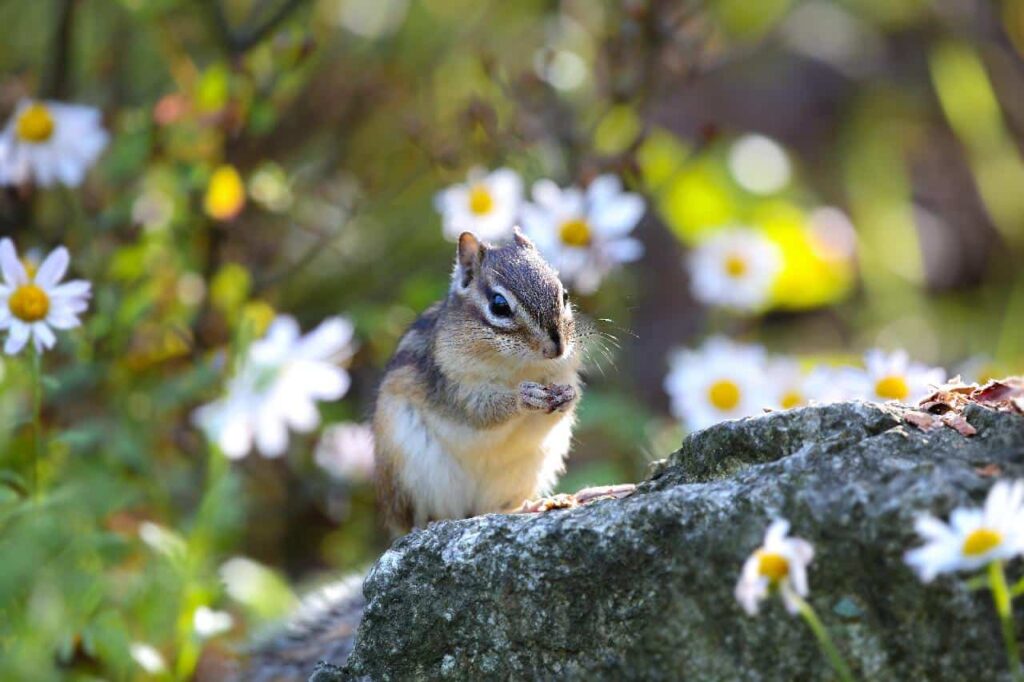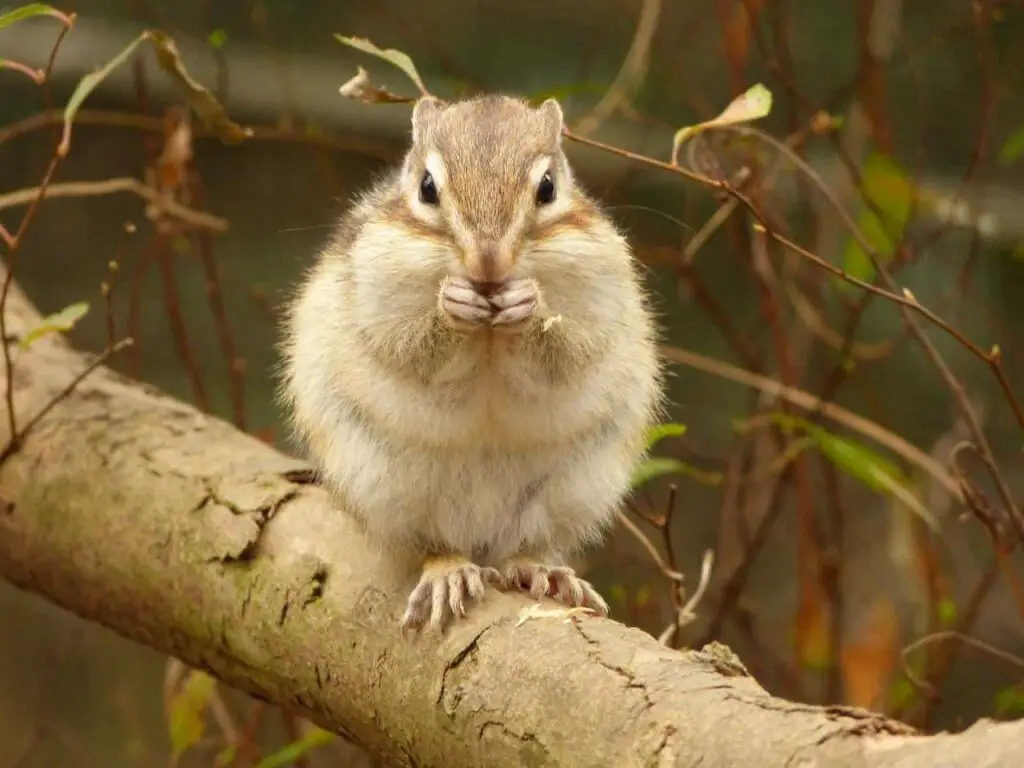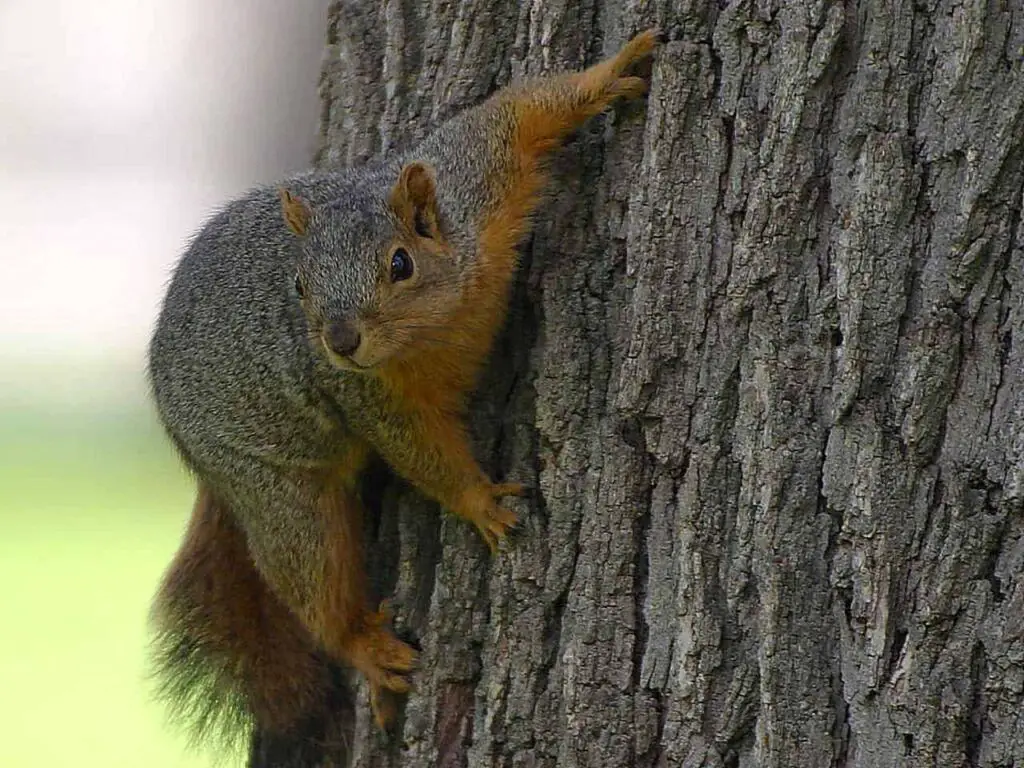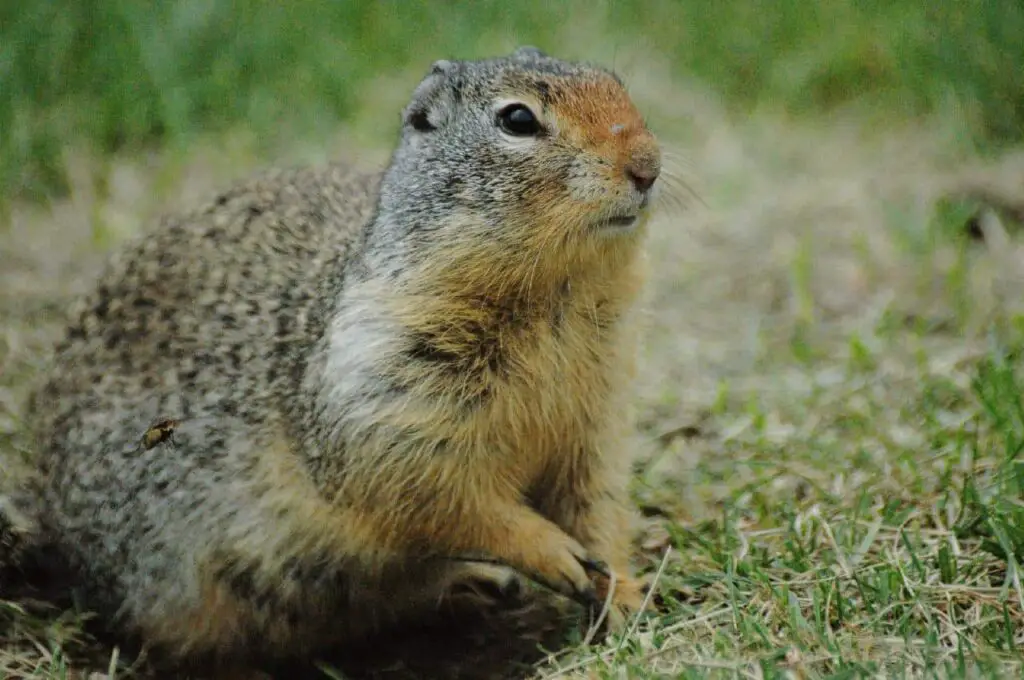
Chipmunks and squirrels both belong to the Sciuridae family. Although these rodents are similar in appearance, there are several significant differences between them. They behave in similar ways to each other yet exhibit distinct traits and characteristics.
When comparing squirrels versus chipmunks, the one is often mistaken for the other; however, they are entirely different. Chipmunks have the same shape as squirrels, yet they are smaller with distinctive stripes down their backs and faces. Chipmunks don’t have a reputation for being a pest.
Although squirrels are considered a nuisance, they and chipmunks are fascinating creatures. Squirrels are intelligent and outmaneuver predators by running in zigzags. Chipmunks, although the smaller cousin, is equally intelligent.
Table of Contents
- Squirrels vs Chipmunks
- Tree Squirrels vs Chipmunks
- Ground Squirrel vs Chipmunks
- Flying Squirrel vs Chipmunks
- Conclusion
Squirrels vs Chipmunks

Although their body shape is essentially alike, squirrels are larger, longer, and heftier than chipmunks. Their coloring, patterns, and fur possess noteworthy differences. The primary features that identify a chipmunk are its diminutive form and its back and face stripes.
At an average weight of 1 – 5 ounces, chipmunks are the smallest member of the Sciuridae family. Squirrels and chipmunks are diurnal; they are mainly active at sunrise and before dusk, except flying squirrels that are nocturnal.
Chipmunks have pouches inside their cheeks that serve to store food while foraging. The big, swollen appearance of the full cheeks is not a reliable identifying feature, as some ground squirrels also have this trait. The size of a full pouch can expand to the size of the chipmunk.
Chipmunks create tunnels that form a series of underground tunnels. The underground burrows are well concealed, with camouflaged entrances. The tunnels can extend 10 – 30 feet long. The nesting area is well maintained, lined with leaves, clean, and hoards food.
Squirrels are especially bothersome to humans. They tend to dig up gardens for bulbs, shoots, and bite through wires. Chipmunks don’t have a bad reputation and generally aren’t considered a nuisance.
There are 25 classifications of chipmunk species ranging from Canada across North America to Mexico, all except for the Siberian chipmunk. The various terrains include deserts, wooded areas, and suburban neighborhoods.
Squirrels are integral to many terrestrial ecosystems. There are approximately 280 species of squirrels. There are three types of squirrels in the Sciuridae family: the tree squirrel, the ground squirrel, and the flying squirrel.
Tree Squirrels vs Chipmunks

The tree squirrel is the largest of all three squirrels; its large shaggy, fluffy tail is its main identifying feature. It has an elongated frame and basic brown coloring. Tree squirrels reside in trees.
| Description | Squirrels (Tree Squirrel) | Chipmunks |
| Genus | Sciuridae- Rodent | Sciuridae- Rodent |
| Size | 5-36 inches | 10 inches |
| Weight | 11-35 ounces (1-1.5 pounds during winter) | 1-5 ounces |
| Appearance | Long, lean bodies, large bushy tail that doubles the length of the body, short thick fur, large ears, and sharp claws (ear tufts) | Small size, have cheek pouches, short tails, the body is the same shape as squirrels |
| Coloring | Black, brown, rust red, and grey | Rusty brown fur, two tan bands, and five black stripes run down its back from neck to rear, black stripes on the face |
| Lifespan | Average 5-12 years can live to 15 years in a sanctuary | 2-5 years depending on the species and environment, in a sanctuary reported cases of 11 years |
| Habitat | Arboreal- build homes in trees | Nest in underground burrows |
| Distribution | On every continent except the poles and Australia, Greenland, and Madagascar | Canada, North America, Mexico, and Parts of Asia (Siberian chipmunk) |
| Diet | Omnivores- Seeds, nuts, fruits, fungi, insects, smaller mammals, and young snakes, tree sap is a delicacy to some species | Omnivores- Seeds, nuts, berries, insects, and small animals |
| Vocalization | Specific vocalization for mating, alarms, and social interaction | Yes- chip and deep chunk sounds and the startle call- ward off predators |
| Mating Habits | Twice a year- December and January, and May to June | Breed twice a year, once in March (spring) and again in July (summer) |
| Traits | Solitary | Solitary |
| Behaviors | Diurnal | Diurnal |
| Hibernation Period | Active all year | 2-3 days at a time, October – March |
| Scatter Hoarding | No need – due to deep hibernation sleep | Store food for the winter |
Summary of Tree Squirrels vs Chipmunks
- Size- tree squirrel 5-36 inches; chipmunks are 10 inches
- Weight- tree squirrel 11-35 ounces; chipmunks 1-5 ounces
- Coloring- tree squirrel black, brown, and rust-red; chipmunks black and tan stripes
- Lifespan- tree squirrel 5-12 years; chipmunks 2-5 years
- Habitat- tree squirrel arboreal; underground burrows
- Diet- Both are omnivores
Ground Squirrel vs Chipmunks

The ground squirrel is very similar in appearance to chipmunks. They are roughly the same proportions, and both have stripes. Frequently ground squirrels are misidentified as chipmunks.
| Description | Squirrels (Ground Squirrel) | Chipmunks |
| Genus | Sciuridae- Rodent | Sciuridae- Rodent |
| Size | 12-14 inches | 10 inches |
| Weight | 21-30 ounces | 1-5 ounces |
| Appearance | Robust little bodies, short, sturdy forelegs, thick thighs, furry, short tails, large, broad feet with a sizeable middle digit for burrowing | Small size, have cheek pouches, short tails, the body is the same shape as squirrels |
| Coloring | Black, brown, rust red, and grey | Rusty brown fur, two tan bands, and five black stripes run down its back from neck to rear, black stripes on the face |
| Lifespan | 5-7 years | 2-5 years depending on the species and environment, in a sanctuary reported cases of 11 years |
| Habitat | Lawn or grassy pastures, meadows, typically shun wooded area- Nest in underground burrows | Nest in underground burrows |
| Distribution | On every continent except the poles and Australia, Greenland, and Madagascar | Canada, North America, Mexico, and parts of Asia (Siberian chipmunk) |
| Diet | Omnivores- seeds, fruits, nuts, fungi, bird eggs, baby birds, | Omnivores- Seeds, nuts, berries, insects, and small animals |
| Vocalization | Specific vocalization for mating, alarms, and social interaction | Chip and deep chunk sound and the startle call- ward off predators |
| Mating Habits | Peak mating cycles twice a year- December and January, and May to June | Breed twice a year, once in March (spring) and again in July (summer) |
| Traits | Highly social– live in colonies | Solitary |
| Behavior | Diurnal | Diurnal |
| Hibernation Period | 3-4 months underground | 2-3 days at a time, October- March |
| Scatter Hoarding | No need- due to deep hibernation sleep | Store food for the winter |
Summary of Ground Squirrels Versus Chipmunks
- Size- ground squirrel 12-14 inches; chipmunks are 10 inches
- Weight- ground squirrel 21-30 ounces; chipmunks 1-5 ounces
- Coloring- ground squirrel black, brown, and rust-red; chipmunks black and tan stripes
- Lifespan- ground squirrel 5-7 years; chipmunks 2-5 years
- Habitat- Both in underground burrows
- Diet- Both are omnivores
Flying Squirrel vs Chipmunks

The flying squirrel has a unique membrane (patagium) attached to its wrists and ankles that assists it in gliding from tree to tree. The patagium is a membrane pelt formed like a parachute that stretches out from wrists to ankles.
| Description | Squirrels (Flying Squirrel) | Chipmunks |
| Genus | Sciuridae- Rodent | Sciuridae- Rodent |
| Size | 8-10 inches | 10 inches |
| Weight | 1.8-2.5 ounces | 1-5 ounces |
| Appearance | Fluffy tails the length of their bodies, ear tufts, furry membrane attached to wrists and ankles for gliding | Small size, have cheek pouches, short tails, the body is the same shape as squirrels |
| Coloring | Grey, brown | Rusty brown fur, two tan bands, and five black stripes run down its back from neck to rear, black stripes on the face |
| Lifespan | An average of six years in the wild and 15 years in a sanctuary | 2-5 years depending on the species and environment, in a sanctuary reported cases of 11 years |
| Habitat | Deciduous and coniferous forests and woodland | Nest in underground burrows |
| Distribution | North America, Central America, Scandinavia, and Southeast and Northern Asia | Canada, North America, Mexico, and parts of Asia (Siberian Chipmunk) |
| Diet | Omnivores- seeds, fruits, nuts, fungi, bird eggs, baby birds, | Omnivores- Seeds, nuts, berries, insects, and small animals |
| Vocalization | Specific vocalization for mating, alarms, and social interaction | Chip and deep chunk sound and the startle call- ward off predators |
| Mating Habits | During February and March | Breed twice a year, once in March (spring) and again in July (summer) |
| Traits | Solitary, group together to stay warm | Solitary |
| Behavior | Nocturnal | Diurnal |
| Hibernation Period | Active all year round | 2-3 days at a time, October- March |
| Scatter Hoarding | No need- due to deep hibernation sleep | Store food for winter |
Summary of Flying Squirrel vs Chipmunks
- Size- flying squirrel 8-10 inches; chipmunks are 10 inches
- Weight- flying squirrel 1.8-2.5 ounces; chipmunks 1-5 ounces
- Coloring- flying squirrel grey, brown; chipmunks black and tan stripes
- Lifespan- flying squirrel 6-15 years; chipmunks 2-5 years
- Habitat- flying squirrel arboreal; chipmunks underground burrows
- Diet- Both are omnivores
Conclusion
Squirrels and chipmunks are alike. These rodents of the Sciuridae family have the same body shape but different coloring and size. A chipmunk is smaller with black stripes down its back and on its face.
The tree squirrel has a sizeable bushy tail that assists it with balance. The chipmunk lives in a network of underground burrows, as does the ground squirrel, not the flying or the tree squirrel.
References:
Forest Preserve District of Will County: WHAT’S THE DIFFERENCE: CHIPMUNK VS. GROUND SQUIRREL
AZ Animals: Chipmunk vs Squirrel: 7 Main Differences Explained
The Conversation: Why do chipmunks live on the ground but squirrels live in trees?
Pediaa.Com: What is the Difference Between Chipmunk and Squirrel
AllThingsNature: What is the Difference Between a Squirrel and a Chipmunk?
University of Saskatchewan: Why do chipmunks live on the ground but squirrels live in trees?
Neeness: Are Chipmunks Part Of The Squirrel Family?
National Wildlife Federation Blog: NOT Alvin and the Chipmunks: 10 Facts You May Not Know about the Real Rodents
Differencebetween.net: Difference Between Squirrel and Chipmunk
PAWS: Squirrels and Chipmunks
Pets on Mom.com: DIFFERENCES BETWEEN A CHIPMUNK AND A SQUIRREL
Live Science: Chipmunk Facts
New Hampshire’s PBS Station: Sciuridae – squirrels, chipmunks, marmots, prairie dogs
Treehugger: 10 Things You Don’t Know About Chipmunks
National Wildlife Federation Blog: 10 Nutty Facts to Make You Appreciate Squirrels
Quora: What are the main characteristics between a squirrel and a chipmunk?
KnowledgeNuts: The Difference Between Chipmunks And Squirrels
Animal Diversity Web: Sciuridae
Wildlife Damage: Chipmunk & Ground Squirrel
National Geographic: Flying squirrels
National Wildlife Federation: Flying Squirrels
National Geographic: Squirrels
Pets on Mom.com: WHAT TIME OF THE YEAR DO SQUIRRELS COME OUT?
UC Statewide IPM Program: Ground Squirrel
CT.gov: Flying Squirrels
